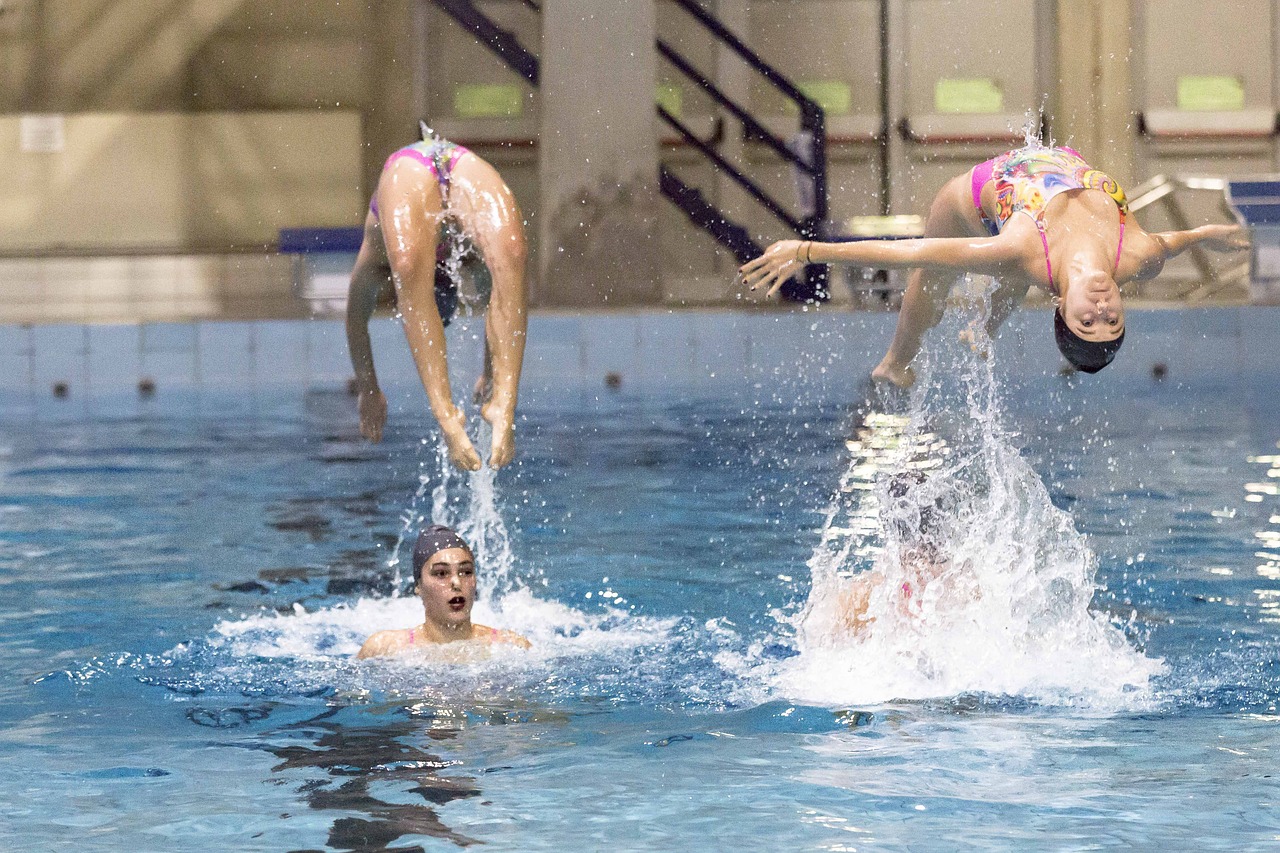The Intricate World of Competitive Synchronized Swimming
Synchronized swimming, a mesmerizing blend of artistry and athleticism, has captivated audiences for decades. This aquatic spectacle combines elements of dance, gymnastics, and swimming, demanding extraordinary skill, strength, and precision from its practitioners. As we dive into the depths of this unique sport, we'll explore its rich history, technical intricacies, and the dedication required to excel in the pool.

The Origins of Synchronized Swimming
Synchronized swimming’s roots can be traced back to the late 19th and early 20th centuries, evolving from water ballet performances. The sport gained popularity in the 1920s and 1930s, with early pioneers like Australian swimmer Annette Kellerman and American Katherine Curtis contributing to its development. Kellerman’s aquatic performances and Curtis’s “rhythmic swimming” classes laid the foundation for what would become modern synchronized swimming.
The sport’s competitive aspect began to take shape in the 1940s and 1950s, with the first official competition held in 1949. The International Swimming Federation (FINA) recognized synchronized swimming as a discipline in 1952, paving the way for its inclusion in major international competitions. In 1984, synchronized swimming made its Olympic debut at the Los Angeles Games, featuring solo and duet events.
Since then, the sport has continued to evolve, with rule changes, technical advancements, and increased global participation shaping its trajectory. Today, synchronized swimming is practiced in over 100 countries, with major competitions held at the Olympic Games, World Championships, and continental events.
The Technical Aspects of Synchronized Swimming
At its core, synchronized swimming is a highly technical sport that requires mastery of various elements. Competitors must demonstrate proficiency in several key areas:
-
Figures: These are prescribed movements performed individually, testing a swimmer’s ability to maintain specific body positions and execute precise movements in the water. Figures form the foundation of synchronized swimming technique and are judged separately in some competitions.
-
Routine Composition: Competitive routines are carefully choreographed sequences that combine athletic prowess with artistic expression. Routines can be performed as solos, duets, mixed duets, or team events, each with its own set of requirements and challenges.
-
Synchronization: As the name suggests, perfect synchronization between swimmers is crucial. This extends beyond matching movements to include timing, spacing, and even facial expressions.
-
Propulsion Techniques: Synchronized swimmers use a variety of specialized techniques to move through the water, including eggbeater kicks, sculling, and unique arm movements that allow them to maintain stability and execute lifts and other complex maneuvers.
-
Breath Control: Perhaps one of the most challenging aspects of the sport is the ability to perform extended sequences underwater. Swimmers must develop exceptional lung capacity and breath control to execute their routines while maintaining a smile and making the difficult appear effortless.
-
Lifts and Acrobatics: Many routines incorporate dramatic lifts and throws, where swimmers propel their teammates out of the water to create visually stunning effects. These elements require immense strength, timing, and coordination.
Training Regimens and Physical Demands
The path to becoming an elite synchronized swimmer is arduous and requires dedication from a young age. Most competitive swimmers begin training in their early teens or even younger, devoting countless hours to perfecting their craft both in and out of the water.
A typical training regimen for a high-level synchronized swimmer includes:
-
Pool Sessions: Swimmers spend several hours each day in the pool, working on technique, routines, and endurance. These sessions often include both land drilling (practicing routines on the pool deck) and water work.
-
Strength Training: Dry land exercises focus on building core strength, flexibility, and overall muscular endurance. This includes weightlifting, Pilates, yoga, and specialized exercises designed to mimic movements performed in the water.
-
Cardiovascular Conditioning: To build the stamina required for long routines, swimmers engage in various forms of cardio training, including running, cycling, and high-intensity interval training.
-
Flexibility Work: Extensive stretching and flexibility training are essential to achieve the graceful lines and extreme positions required in routines.
-
Mental Preparation: Like many high-level sports, synchronized swimming demands mental toughness and focus. Visualization techniques, meditation, and sports psychology sessions are often incorporated into training programs.
-
Artistic Development: Many synchronized swimmers also study dance, gymnastics, or other performing arts to enhance their artistic expression and choreographic skills.
The physical demands of synchronized swimming are often underestimated. Athletes must possess exceptional lung capacity, able to hold their breath for extended periods while performing strenuous movements. The sport also requires a unique combination of strength and grace, with swimmers needing powerful leg muscles to execute propulsive movements and maintain inverted positions, while simultaneously demonstrating fluidity and artistry in their upper body movements.
Judging and Scoring in Competitive Synchronized Swimming
Competitive synchronized swimming events are judged based on a complex set of criteria that evaluate both technical merit and artistic impression. The scoring system has evolved over the years to better reflect the sport’s combination of athleticism and artistry.
In major international competitions, routines are typically judged by a panel of experts who assess various elements:
-
Technical Merit: This includes the execution of required elements, synchronization, difficulty of movements, and overall precision.
-
Artistic Impression: Judges evaluate choreography, interpretation of music, use of pool space, and the overall impact of the performance.
-
Execution: This encompasses the quality of movements, extension, height out of the water, and stability in various positions.
-
Difficulty: More challenging elements and combinations receive higher scores, encouraging innovation and pushing the boundaries of what’s possible in the sport.
-
Synchronization: Perfect timing between swimmers is crucial, with even slight discrepancies resulting in point deductions.
The judging process is intricate, with scores typically given on a scale from 0 to 10, with decimal points used to differentiate between performances. The final score is a combination of these various components, with different weightings applied depending on the specific competition and event.
The Evolution of Competitive Synchronized Swimming
Over the decades, synchronized swimming has undergone significant changes in terms of rules, techniques, and overall spectacle. Some key developments include:
-
Mixed Duets: In 2015, FINA introduced mixed duets (male and female pairs) in major competitions, adding a new dimension to the sport and challenging traditional gender norms.
-
Technological Advancements: Underwater speakers, improved pool design, and high-tech swimwear have all contributed to enhancing performance and spectator experience.
-
Acrobatic Elements: Modern routines incorporate increasingly complex and daring acrobatic moves, with swimmers being propelled high out of the water in dramatic displays of strength and coordination.
-
Music Selection: While classical music was once the norm, contemporary routines often feature a wide range of musical styles, including pop, rock, and electronic music, allowing for more diverse and dynamic choreography.
-
Training Techniques: Advanced sports science has led to more sophisticated training methods, including the use of underwater cameras for technique analysis and specialized equipment for dry land training.
Challenges and Controversies in Synchronized Swimming
Despite its beauty and complexity, synchronized swimming faces several challenges and controversies:
-
Gender Stereotypes: The sport has long been associated predominantly with female participants, leading to stereotypes and misconceptions about its athletic demands. The introduction of mixed duets is helping to challenge these perceptions.
-
Judging Subjectivity: As with many aesthetic sports, synchronized swimming judging can be subjective, leading to debates about scoring and results.
-
Health Concerns: The intense physical demands and need for extreme breath control have raised concerns about potential health risks, particularly related to hypoxia (oxygen deprivation) during underwater sequences.
-
Accessibility: The sport requires specialized facilities and extensive training, making it less accessible in many parts of the world compared to other aquatic disciplines.
-
Olympic Status: While synchronized swimming has been an Olympic sport since 1984, there have been occasional debates about its place in the Games, with some arguing for its removal in favor of other disciplines.
The Global Landscape of Synchronized Swimming
Synchronized swimming has a diverse global landscape, with different countries excelling in various aspects of the sport. Russia has long been a dominant force, known for its technical precision and innovative choreography. Other powerhouses include China, Japan, and Spain, each bringing unique strengths to their performances.
The sport’s popularity varies significantly across regions:
-
Europe: Countries like Russia, Spain, and Italy have strong traditions in synchronized swimming, with well-established training programs and consistent success in international competitions.
-
Asia: Japan and China are particularly strong, with growing programs in countries like South Korea and Kazakhstan.
-
North America: The United States and Canada have historically been competitive, though their dominance has waned in recent years compared to European and Asian teams.
-
Oceania: Australia has a notable synchronized swimming program, although it faces challenges in terms of funding and athlete development compared to some other aquatic sports.
-
South America: Brazil and Mexico have shown promise in recent years, with increasing investment in the sport and improved performances at international events.
The global nature of synchronized swimming has led to a rich exchange of techniques and styles, with teams often incorporating elements from different cultural traditions into their routines. This cross-pollination of ideas has contributed to the sport’s evolution and the increasing complexity of competitive performances.
The Role of Technology in Modern Synchronized Swimming
As with many sports, technology has played an increasingly important role in the development and practice of synchronized swimming:
-
Underwater Cameras: High-definition underwater cameras allow coaches and athletes to analyze technique and synchronization with unprecedented detail. This technology has revolutionized training methods and performance analysis.
-
Sound Systems: Advanced underwater sound systems ensure that swimmers can hear the music clearly throughout their routines, enabling better synchronization and artistic expression.
-
Swimwear Innovation: Specially designed swimsuits help enhance performance by reducing drag and improving buoyancy. These suits are often adorned with intricate designs and sequins to add to the visual spectacle of performances.
-
Virtual Reality Training: Some teams have begun experimenting with virtual reality technology to help swimmers visualize routines and perfect their spatial awareness out of the water.
-
Biometric Monitoring: Wearable technology allows coaches to monitor athletes’ vital signs and performance metrics, helping to optimize training and prevent overexertion.
-
Pool Design: Modern competition pools are often designed with synchronized swimming in mind, featuring specific depths, lighting systems, and even movable floors to create ideal conditions for performances and training.
The Artistic Elements of Synchronized Swimming
While the athletic demands of synchronized swimming are significant, the artistic aspects of the sport are equally crucial. Choreographers and swimmers work together to create routines that are not just technically impressive but also emotionally engaging and visually stunning.
Key artistic elements include:
-
Musicality: Routines are carefully choreographed to match the rhythm, tempo, and mood of the chosen music. This synchronization between movement and sound is fundamental to the sport’s aesthetic appeal.
-
Thematic Expression: Many routines are built around specific themes or stories, with swimmers using their movements and expressions to convey narratives or emotions.
-
Costume Design: Swimsuits and headpieces are carefully designed to complement the routine’s theme and enhance the visual impact of the performance. These costumes often feature intricate details and vibrant colors.
-
Facial Expressions: Despite the physical demands of their routines, synchronized swimmers must maintain expressive faces throughout their performances, conveying emotion and engaging with the audience and judges.
-
Use of Space: Choreographers must consider how to effectively use the entire pool space, creating dynamic patterns and formations that are visually appealing from multiple angles.
-
Artistic Transitions: The seamless flow between different elements of a routine is crucial, with swimmers creating smooth and graceful transitions that maintain the overall aesthetic of the performance.
The combination of these artistic elements with the sport’s technical requirements creates a unique fusion of athleticism and artistry that sets synchronized swimming apart from many other competitive disciplines.
The Future of Synchronized Swimming
As synchronized swimming continues to evolve, several trends and developments are shaping its future:
-
Increased Male Participation: With the introduction of mixed duets in international competition, there is growing interest in male participation in the sport. This trend is likely to continue, potentially leading to the development of all-male events in the future.
-
Technological Integration: As technology advances, we can expect to see even greater integration of high-tech elements in both training and performance. This might include augmented reality displays for spectators or more sophisticated biometric monitoring for athletes.
-
Cross-Disciplinary Influence: There is a growing trend of incorporating elements from other disciplines such as contemporary dance, circus arts, and even martial arts into synchronized swimming routines, pushing the boundaries of what’s possible in the water.
-
Environmental Consciousness: As with many sports, there is an increasing focus on sustainability in synchronized swimming. This may lead to innovations in pool design, water treatment, and even costume materials to reduce the sport’s environmental impact.
-
Virtual Competitions: The global pandemic has accelerated the development of virtual competition formats in many sports, including synchronized swimming. This trend may continue, allowing for more frequent international competitions and increased global participation.
-
Rule Evolutions: As the sport progresses, we can expect continued refinement of judging criteria and competition rules to better reflect the evolving nature of performances and to maintain fairness in scoring.
-
Increased Athleticism: The physical demands of the sport are likely to continue increasing, with routines incorporating even more acrobatic elements and pushing the limits of human performance in the water.
Conclusion: The Enduring Appeal of Synchronized Swimming
Synchronized swimming stands as a testament to the incredible capabilities of the human body and spirit. It combines the raw physicality of elite athleticism with the expressive power of artistic performance, creating a spectacle that continues to captivate audiences around the world.
As the sport evolves, it faces challenges in maintaining its relevance and appeal in a rapidly changing sports landscape. However, the unique blend of skills required for synchronized swimming – strength, grace, teamwork, and artistic expression – ensures its enduring appeal. The sport offers a platform for athletes to push the boundaries of what’s possible in the water while creating moments of breathtaking beauty.
From its humble beginnings as a form of aquatic entertainment to its current status as a highly competitive Olympic discipline, synchronized swimming has come a long way. As it continues to adapt and innovate, the sport promises to remain a fascinating and awe-inspiring domain of human achievement, celebrating the harmonious union of athleticism and artistry in the aquatic realm.





